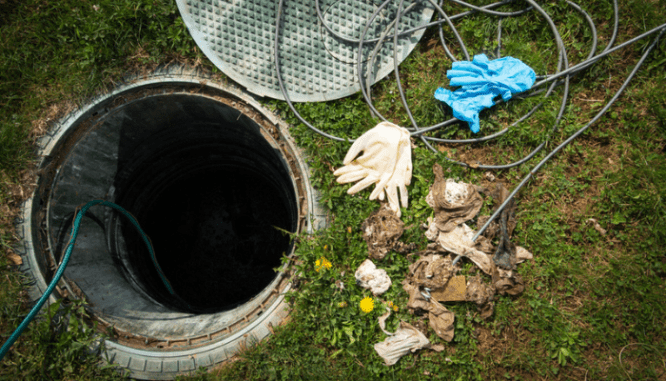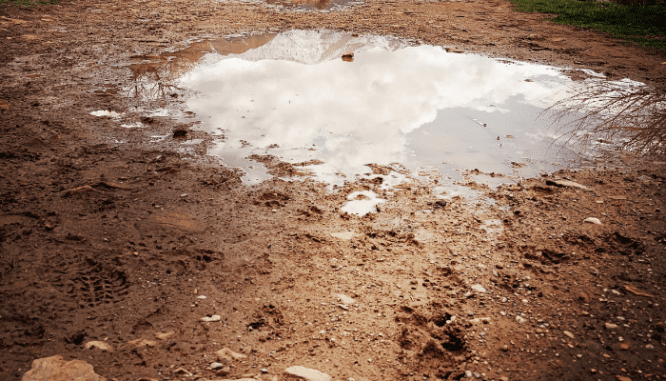House Septic Tanks Don’t Come with Care Instructions. Here’s What You Need to Know.
- Published on
- 10 min read
-
 Lori Lovely Contributing AuthorClose
Lori Lovely Contributing AuthorClose Lori Lovely Contributing Author
Lori Lovely Contributing AuthorLori Lovely edited the Real Estate Home section for the Indianapolis Star and covered the annual Dream Home construction and decor for Indianapolis Monthly magazine. She has written guides for selling houses and more.
If you’ve ever lived in a rural area, you’re familiar with the term “well and septic.” As many as one in five households nationwide get their water from a well and rely on a septic system to dispose of wastewater. That means one out of every five homeowners needs to maintain a septic system. The results of neglect aren’t pretty — and they don’t smell too good, either!
All too often, homeowners take their house’s septic systems for granted, neglecting and even abusing them — until disaster strikes and an expensive emergency repair is needed.
To help you care for your house’s septic tank, we’ll share some tips on maintenance and repairs with insight from a wastewater treatment professional.

Get to know your septic system and its location
You may have better things to do on a Saturday, but becoming acquainted with your home’s septic system, its location, and how it works could save you money and mess in the long run.
Find your field
If you don’t know where your septic tank and drain field are, you need to locate this critical infrastructure. Start by finding the sewer line leading from your house. Once you encounter the 4-inch sewer pipe, probe the ground every few feet until you find the septic tank, which is required to be at least 5 feet from the house, although a typical distance is closer to 10 to 25 feet, with a depth ranging from 4 inches to 4 feet.
You can also check the county records or local health department for “as-builts” with diagrams. Just keep in mind that the older the record, the more difficult it may be to read the map, as landmarks such as trees and outbuildings may have changed since it was drawn, and not all older diagrams are to scale.
Verify which type of septic system you have
There are two basic types of septic systems: conventional and alternative.
The basic systems use gravity, while pressure distribution systems use a pump to distribute effluent from the tank through the drain field. Most newer installations use a pump.
Alternative systems include:
- Aerobic treatment units that use oxygen to break down solids for cleaner wastewater (often used in environmentally sensitive areas)
- Mound systems in which the drain field is raised above ground level due to minimal available soil
- Sand filter systems, also used when minimal soil is available, but including use of a sand filtering system and pump to treat and disburse effluent
Note the septic tank systems materials
The first step to maintaining your septic tank is knowing what type of system you have. There are several types of septic tanks, each with varying longevity.
Concrete septic tanks
A concrete septic tank should last 40 to 50 years unless subjected to acidic wastewater. As bacteria breaks down the solid waste inside your septic system, it produces hydrogen sulfide gas. When hydrogen sulfide mixes with water vapor, it becomes sulfuric acid, which erodes concrete. To combat that effect, vents above the leach field should be kept open and clear of debris. Homeowners should clean vents as necessary and have them inspected as part of the overall septic tank inspection.
Steel septic tanks
A steel tank isn’t subject to the same corrosion as a concrete tank but may last only 20 to 30 years. These systems most commonly fail when the baffles rust. Baffles are components made of fiberglass, steel, or concrete designed to slow wastewater distribution into the drain field until it has sufficiently distilled solids. Older systems may collapse under pressure if you drive over them.
Plastic septic tanks
Steven Lewis, master installer and inspector of wastewater treatment systems and owner of Nebraska Septic, prefers plastic tanks, which can last more than 40 years. More affordable than concrete tanks, rust-resistant, watertight, and immune to water-based corrosion, plastic tanks are more sensitive to soil conditions and environmental changes. They are also more susceptible to being crushed if driven over.
Gauge your septic system’s size
The size of the septic system determines how much wastewater it can process efficiently. Most residential houses have a septic tank that averages 750 to 1,250 gallons. The size of a septic tank is usually based on the house’s square footage and the number of people living there.
Rather than calculate square footage, an easier way to do it has traditionally been to count the number of bedrooms. The bedroom calculation is based on two adults per bedroom, Lewis explains. But that estimate is just the starting point. “If you have a big tub, like a soaking tub, you’ll want to upsize [the septic tank],” he says. The reason is that emptying it will be a “big dump” that stirs the tank.
Home additions that are larger than 10% of the house’s floor plan or increase the number of bathrooms will likely require a new, larger septic tank. In some instances, you may get by installing an aerobic treatment unit with your existing system.

Maintenance
Now that you’re familiar with your house’s septic system, it’s time to learn how to take care of it to avoid maintenance mishaps.
Inspect your septic tank every one to three years
If you can’t remember the last time you inspected your tank, it’s probably time to schedule an inspection. According to the EPA, you should check your house’s septic tank every three years. Homeowners can do this inspection themselves by performing the “stick test,” but most prefer to call a professional.
Some authorities, like the National Association of Certified Home Inspectors, recommend an inspection every year. If you have an alternative system featuring pumps, electrical float switches, or mechanical components, you should inspect your septic system annually. When in doubt, ask your inspector the recommended frequency for your system.
Here’s how a septic tank inspection works
A certified inspector — a private contractor, someone from the Health Department, or a wastewater professional — will locate the underground tank if you’re unsure where it is. They may flush a small radio transmitter down the toilet and trace it to find the system.
Next, the inspector will look for leaks and measure the level of solids in the tank, including the scum and sludge layers, using a sludge judge, a long, hollow pole. They will also check the baffles to make sure they’re not covered by solids, that they’re several inches higher than the sewage level, and that there’s no evidence of previous overflows.
Once the inspection is complete, the inspector will give you a service report detailing your tank’s condition. It’s important to save these records for reference.
An inspection typically costs about $100 to $250 and should take under three hours to complete. You can find a list of professionals on sites like Angie’s List and Thumbtack, or check the National Onsite Wastewater Recycling Association’s website.
Don’t forget the D-box — check it regularly
One oft-forgotten piece of the septic system is the distribution box, or D-box, a component between the septic tank and the drain field that ensures even distribution of wastewater to all the drain field lines. Usually constructed of precast concrete, it features multiple holes for the different lines.
The D-box doesn’t usually have to be pumped, but it should be part of the septic system inspection. You should look for:
- Damage of the outlets and openings causing restricted flow
- Tilting or tipping, resulting in distribution to only part of the leach field, and possibly a backup or clog
- Structural integrity.
A concrete D-box should last 20 years unless tree roots have penetrated it, heavy machinery has damaged it, or sludge has built up. Signs of a failed box are comparable to a septic tank blockage or drain field issue.
Pump your septic tank every three to five years
In general, you should pump your septic tank every three to five years to remove solid waste, scum, and sludge. You must pump tanks in colder climates more frequently since colder temperatures inhibit bacterial action, resulting in less decomposition of solid waste.
With a properly sized tank getting moderate use, Lewis says it’s possible to go five to eight years without pumping, although he agrees that it’s better to pump more often than not often enough.
Your records will indicate when it’s time to pump, but other factors that influence the frequency of removing solids and sludge from your tank include tank size, volume of wastewater, and how many solids are in it.
Septic tanks have a T-shaped outlet to prevent sludge and scum from leaving the tank. If the bottom of the scum layer reaches within 6 inches of the bottom of the outlet, or if the top of the sludge layer gets to within 12 inches of the outlet, it’s time to pump the tank.
Pumping is not a DIY project. The germs and gasses in your house septic tank can be harmful. Call a professional. According to Home Guide, the typical cost of pumping out your tank runs between $295 and $610.

Look for signs that it’s time to empty your tank
What goes up must come down. By the same token, what goes in eventually must come out. Here are some signs that it’s time to empty your house septic tank.
Foul, lingering odor
If a septic tank is full, the gases are pushed back up the pipes, resulting in odor coming through your drains. Because the septic system also collects gray water from the shower, washing machine, dishwasher, and sinks, these areas may emit a foul odor when the tank is full.
“That smell is decay,” Lewis elaborates. It’s the good bacteria dying off.” Your septic tank relies on bacteria to break down waste. That’s why you’re not supposed to flush medicines like antibiotics down the drain — they can kill these necessary decomposers.
Slow drainage
If your septic tank is full, you may also notice your drains become slow or backed up. These signs could be due to a clog, but if you’ve tried in vain to remove the “clog,” it’s likely due to a full tank.
Standing water
If water pools around the tank, it’s probably a sign that the tank is overflowing. “If you see wet spots or water sitting on the yard,” Lewis indicates, “call an expert.”
Grass that looks too green and lush
If the grass over your septic system looks too healthy, it could be a sign that your system is leaching into your yard and fertilizing the grass.
Missing pieces
If you don’t see solids on top of the slurry in the septic tank, the baffle may be bad. “The outlet baffle is one of the main components,” Lewis says. A damaged baffle could lead to leach field failure.
Maintain the drain field
The drain field plays a key role in the septic system by removing contaminants from the liquid that comes out of the septic tank; it requires routine maintenance.
There are different types of drain fields. One of the most common consists of perforated pipe and gravel buried underground, Lewis says. Another often-used style involves a leaching chamber. A leaching chamber consists of trenches with distribution pipes or open-bottomed plastic chambers that use the soil underneath to provide the final treatment and disposal of the effluent.
Under the right conditions and if properly maintained, a drain field should last 50 years or more. But if organic matter and solids build up faster than the soil microbes break them down, a drain field can fail prematurely.
Keep the area above the drain field clear
You should leave the grass above the drain field undisturbed. Heavy objects like cars and playground equipment may compact the soil and impede proper drainage. It could also crush components, or the chambers could collapse, Lewis notes.
Replacing a crushed or damaged pipe is only about $1,520. Replacing the entire leach field can cost $2,500 to $10,000 because it involves digging up the septic system and finding a new, uncontaminated area to place it.
Divert water from the drain field
Saturated ground renders a drain field incapable of managing liquid waste, slowing or halting the wastewater treatment process. To prevent pooling water, turn gutter downspouts, roof drains, sump pumps, and all rainwater drainage systems away from the field.
Keep (most) trees away from the drain field
If tree roots encroach on a leach field, they can wreak havoc by puncturing the tank, crushing the system’s components, compacting the soil, or causing backups. Some sources believe that trees should be at least 100 feet away; willows and other trees with extremely aggressive roots should be even farther away. However, Lewis notes that while some tree roots can prevent water dispersal, willow trees in the right place can actually help get rid of the effluent. He recommends planting trees at the end of the laterals, the perforated pipes extending from the septic tank’s outlet.

Tips for protecting your house septic system
There are things you can do to avoid a crisis situation with your house septic tank and drain field. Many of the following suggestions have additional benefits, as well.
Use less water
“Consider conservation of water,” Lewis urges. Large “dumps” of water can cause a septic system to fail, he explains. In effect, it “floods.” If the soil under a septic system can’t absorb all the water, there’s not enough time for the sludge and scum to separate. The system needs to rest.
- Turn off the faucet while you wash dishes, brush your teeth, or wash your hands. Don’t let the water run.
- Attach an aerator nozzle to faucets that allow you to adjust the water pressure.
- Check for leaks and repair any you find.
- Run the dishwasher and washing machine only with full loads.
- Don’t run more than one load of wash per day; spread out the laundry throughout the week to allow the septic system time to process the water. Lewis explains that the leach field “needs to breathe.” It’s pertinent to spread out laundry loads during the winter in cold climates because the warm discharge elevates the tank’s temperature, benefiting the bacteria.
- Buy appliances with the Energy Star label. They save 35% on energy and up to 50% on water.
- Drain your water softener away from the septic field. Lewis explains that water softeners dump large amounts of water overnight when the septic system needs to be resting.
However, there are times when more water is better. Don’t buy a high-efficiency toilet. The toilet accounts for about 25% to 30% of all water used in a typical house. Older toilets have reservoirs that range from 3.5 to 5.0 gallons. Newer toilets use only 1.6 gallons per flush. “A low-flow toilet is the last thing you want,” Lewis says, explaining that good flow is needed to push solids — especially if the distance between the house and the house septic tank is long.
Install French drains
French drains can discharge water from the water softener away from the house and septic field. “Water softeners produce a lot of salt,” Lewis indicates. “It’s a major concern.” This salt stays in the system and prevents the soil from working.
Be mindful of what you put into your septic system
Only put material in your septic system that can decompose. Items that don’t break down can cause clogs and backups.
- Don’t use the toilet as a garbage disposal. Never flush hair, cat litter, paper towels, feminine hygiene products, condoms, diapers, cigarette butts, or facial tissues. These items could clog your toilet and eventually will clog your house septic tank.
- Use high-quality toilet tissue that easily dissolves when wet.
- Don’t pour grease or cooking fat down the drain. It can plug the inlet in your septic system or clog the drain field. “‘Fats and grease’ include soap,” Lewis reveals. Use soap and shampoo sparingly.
- Use the garbage disposal prudently. Never put coffee grounds, egg shells, pasta, or flour in the disposal. When you do use the garbage disposal, avoid overloading it to give your septic system time to process material.
- Minimize usage of household chemicals and heavy-duty cleaners. Chemical disinfectants kill the microorganisms that work to decompose the waste in your septic system. Drain cleaners are the worst, but too much bleach, detergent, or other common household chemicals also have a detrimental effect.
- Don’t put hazardous chemicals in your septic system. Toxic chemicals and oils such as paint thinner, gasoline, motor oil, and varnish are unhealthy for groundwater. Always dispose of these items following instructions on the product label’s instructions or according to local law.
Check for leaks
Overloading the house septic tank and drain field diminishes your system’s ability to process wastewater. The EPA estimates that each household member uses about 70 gallons of water each day. However, even a small leak or a running toilet can amount to an additional 200 gallons of water daily. Heavy amounts of water can put a strain on the septic system, rendering it less efficient.
Beware of “septic-safe” products
“It’s a sales gimmick,” Lewis contends. Use hand and dish soaps made from natural products; they’re more environmentally friendly anyway.
Don’t use additives like Rid-X. “I have seen none that benefit the tank,” Lewis divulges, “but I’ve seen many that hurt the process because they eliminate bacteria.”
The Georgia Department of Public Health agrees, pointing out that “scientific studies offer little support for their use.” They do not eliminate or reduce the need to pump out the septic tank and can clog drain field lines or create acids that corrode concrete tanks and D-boxes.

A little septic tank TLC goes a long way
Your house septic tank and drain field are your personal, onsite sewage treatment facility. When properly used and maintained, your system is odorless and unobtrusive.
“Care and maintenance is very important, but tricky,” Lewis comments. However, a well-maintained septic tank could last indefinitely if cared for correctly.
Header Image Source: (Dagmara_K / Shutterstock)
